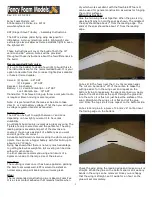
31
Stretch the risers against the wind, separating the right and left one.
We suggest that you lay the risers in the same way as you will be turning during reverse
launch, and place one riser over the other, with rear risers on top.
It should be done this way because once you clip in, the cage of your power unit will make
turning on your own very difficult.
Now run the pre-launch checklist.
After warming up the engine put the power unit on, turn to face the wing, go to the risers and
clip them in the appropriate carabiners.
Pull on the front and rear risers to open the cells.
It is a good idea to pull up the wing briefly in order to check that the lines are not tangled.
Holding the risers, brakes and throttle as described above, pull the front risers and raise
the
wing
over your head.
On most occasions you won’t have to use the brakes.
Once you have it overhead, turn around, open the throttle and take off.
Remember:
•
You are launching with your hands crossed. You have to perfect this technique before
trying it with a running engine on your back.
•
Any brake operation (or steering inputs in general) should be smooth and gentle.
•
Do not try to take off until you have your wing overhead,
applying the throttle
early can cause dangerous oscillations.
•
Do not sit in the harness until you are sure you are flying!
•
The faster the trim setting is, the more brake input is required to take off.
•
When clipping in the crossed risers, you can find proper connection of the speed
system particularly hard. Be careful not to confuse the risers!
6.2.3 CLIMBING
Once you are safely airborne, continue heading against the wind, using brakes to correct
the direction.
Do not try to climb too steeply.
In powered flight the
NRG PRO II/NRG XC II
behaves more like an airplane than a
paraglider, and it is good idea to regard it as such. If there are no obstacles present, it is
by far safer to fly level for a while after take-off, clearing the ground gradually, gaining
some speed before converting it to height with a brief pull on the brakes.
Another reason not to try climbing too steeply is the risk connected with engine failure at
low altitude.
NRG PRO II/NRG XC II
in a steep climb does not stay behind as much as conventional
paragliders.
The SRS prevents or delays possible stall, but low speed at low altitude carries inherent
danger of stall which even SRS will not be able to fully prevent
Besides, you should always be able to land safely in case of engine malfunction, so it’s
Summary of Contents for NRG Pro II
Page 14: ...www apcoaviation com 14...
Page 37: ...www apcoaviation com 37 12 NRG PRO II NRG XC II SKETCHES...
Page 38: ...www apcoaviation com 38...
Page 39: ...www apcoaviation com 39...
Page 40: ...www apcoaviation com 40...
Page 41: ...www apcoaviation com 41...
Page 42: ...www apcoaviation com 42...
Page 43: ...www apcoaviation com 43 APCO wishes you many hours of enjoyable flying Take Air...

































